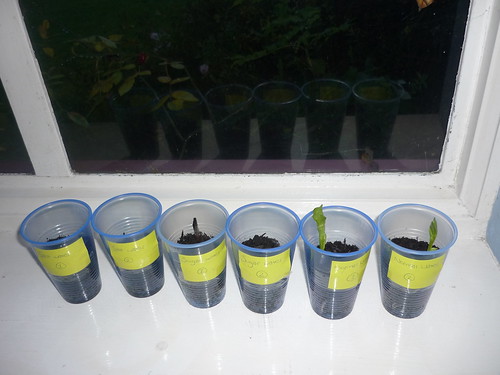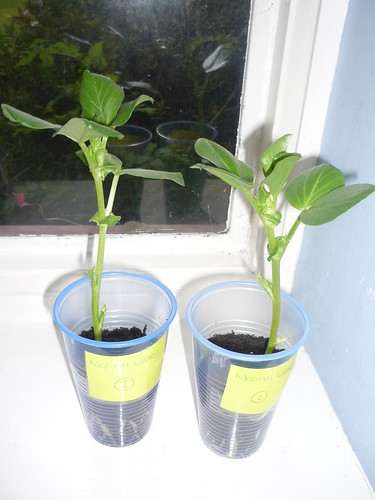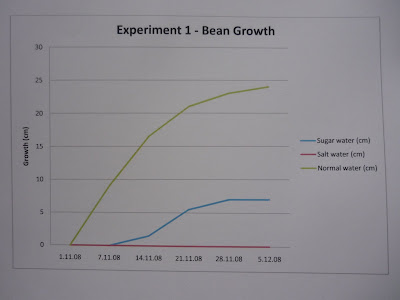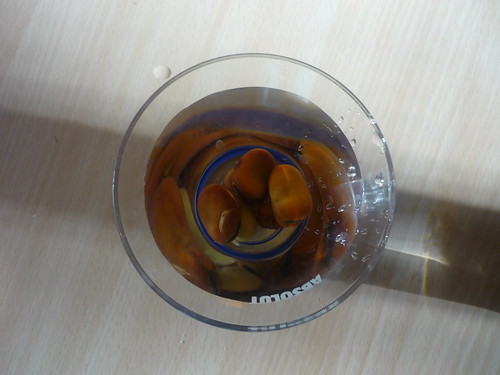Our investigation supported our assumption that the beans watered with normal water would grow the quickest. These beans also grew the tallest and appeared to be the healthiest of all the beans we studied. We also discovered that one of the bean watered with sugar water sprouted and grew a little, which suggests that sugar water is not as detrimental to bean development as salt water as the beans watered with this type of water did not appear to grow at all.
Our investigation was fairly valid for several reasons. Firstly, we used two beans to test each condition. This was because some beans may have been anomalies and unable to grow, therefore the use of two beans meant that we had a greater chance of comparing the two and of noticing if there were any abnormal results. The investigation also had validity in that all beans were treated in the same manner at the beginning of the experiment and more importantly, all beans germinated successfully. This meant that all beans had an equal chance of growing if kept in the right environmental conditions and treated in the correct way.
Our investigation was also fairly reliable in that our instructions for how we germinated the beans, how we looked after the beans and how we mixed our solutions were clear, detailed and precise meaning that a person wishing to replicate the study could do so easily and accurately.
We discovered that one of the beans watered with the sugar water did sprout. Does this suggest that beans watered with sugar water are able to grow successfully? If so, why did the other bean watered with sugar water not sprout? Perhaps a future investigation could involve more beans being studied in each condition. Although we attempted to make the experiment more valid by using two to each condition, this number is small and is hard to spot abnormal results. A future investigation could use 10 beans per condition and the results may therefore be clearer to analyse. Future study could also look into other plants besides from beans, which may require different types of water in order to survive. For example, plants which live in or close to sea water may thrive in salty water, or those plants which grow in rivers or ponds may require water of a different make up to those that live in our gardens.
There are plenty of questions arising from this investigation with plenty of scope for further investigation.
Wednesday 25 February 2009
Monday 23 February 2009
Discussion of results and our conclusion
The results from Experiment 1 and Experiment 2 both show that the bean grew best when it was in normal water. Over the five weeks the bean that was in normal water in Experiment 1 grew to 24 cms and the bean that was in normal water in Experiment 2 grew to 18cms.
Our hypothesis was therefore correct as we predicted that the broad beans would grow most successfully when in normal water.
The findings from Experiment 1 and 2 both concur that the bean did not grow when in salt water. The experiement therefore reveals that broad beans are not adapted to living in a salt water environment. It appears that the salt upsets the normal workings of the bean causing it to die.
The findings from Experiment 1 show that the bean did grow whilst it was in sugared water, however, it did not grow as successfully as when it was in normal water. Over the five weeks the bean in Experiement 1 that was in sugared water only grew to the height of 7cms, whereas the bean that was in normal water grew to 24 cms.
The results from Experiment 2 differ to those found in Experiment 1 as the bean in Experiment 2 did not grow at all when it was in sugared water.
It would thus seem that sugar, similarly to salt, affects the normal levels in the plant and has has negative effects on generating bean growth. However, as the bean in Experiment 1 was able to grow when in sugared water it implies that sugared water is not as harmful to the broad bean as salt water is.
Our hypothesis was therefore correct as we predicted that the broad beans would grow most successfully when in normal water.
The findings from Experiment 1 and 2 both concur that the bean did not grow when in salt water. The experiement therefore reveals that broad beans are not adapted to living in a salt water environment. It appears that the salt upsets the normal workings of the bean causing it to die.
The findings from Experiment 1 show that the bean did grow whilst it was in sugared water, however, it did not grow as successfully as when it was in normal water. Over the five weeks the bean in Experiement 1 that was in sugared water only grew to the height of 7cms, whereas the bean that was in normal water grew to 24 cms.
The results from Experiment 2 differ to those found in Experiment 1 as the bean in Experiment 2 did not grow at all when it was in sugared water.
It would thus seem that sugar, similarly to salt, affects the normal levels in the plant and has has negative effects on generating bean growth. However, as the bean in Experiment 1 was able to grow when in sugared water it implies that sugared water is not as harmful to the broad bean as salt water is.
Our results
Monday 17 November 2008
Newsflash!!!
News just in...
Sugar 1 has sprouted!!! At the beginning of the week some roots were visible in Sugar 1's pot. When it was time for the Week Two measurements there was a tiny sign of a green leaf poking through the soil.
Sugar 2 however is yet to show any signs of life! Which of the two beans is the anomaly? Should the beans in the sugar water be growing?
Unfortunately, the 'salt water' beans are not looking so hopefull!
Sugar 1 has sprouted!!! At the beginning of the week some roots were visible in Sugar 1's pot. When it was time for the Week Two measurements there was a tiny sign of a green leaf poking through the soil.

Sugar 2 however is yet to show any signs of life! Which of the two beans is the anomaly? Should the beans in the sugar water be growing?
Unfortunately, the 'salt water' beans are not looking so hopefull!

Results so far...

Just a little note to show our results so far.
Our 'normal water' beans were the first to sprout (as shown by this photograph).
The other beans initially showed no sign of growth.
Both of our 'normal water' beans have raced ahead and are by our week two measurements have reached 16.5cm (N1) and 14.5cm (N2)!!!!

How exciting!!!!
Tuesday 11 November 2008
Method
List of apparatus
Method

- 6 beans
- 6 plastic cups
- soil
- sugar
- salt
- water
- 10ml syringe
- ruler
- camera
Method
- Soak the beans for two days in plain water to soften their shells.
- Once softened, remove from water and put in damp kitchen roll and make sure they are covered
- Distribute soil equally between all 6 cups.
- Once germinated, plant one bean in each cup.
- To make the salt and sugar water: mix 5 teaspoons of salt or sugar with 150mls of boiling water. Leave water to cool before watering plants.
- The first time beans are watered, water 2 beans with 20mls sugar water, 2 beans with 20mls salt water and 2 beans with 20mls normal water.
- From then on, water each bean with 10mls of the desired solution every 3 days.
- Observe the growth of the beans, make notes and take pictures of siginificant progress periodically.
- Each week, measure the beans that have sprouted in order to produce quantitative data.

Welcome to our Bean Blog!!

As part of our primary science course we have been asked to carry out an investigation into plant growth. We were given 6 beans, 6 cups and some soil. We have chosen to exlore what effect different types of water has on the growth of the beans. To investigate this we decided to water each plant with different types of water; 2 beans watered with normal tap water, 2 beans watered with sugar water and 2 beans in salt water. We chose these variables because we know that some plants can survive in salt water and so we were interested to see if the beans could grow in these conditions. Likewise, we also wanted to find out if water with sugar in had any effect on beans' growth.
- The dependent variable in this experient is the height of the bean, measured in cms.
- The independent variable is the type of water
- The control variables are the amount of water, the concentration of sugar/salt, the position of the beans.
By having these control variables we are helping to make a fair test. Also, by having 2 beans in each condition and thus repeating the experiement our results will be more reliable and replicable.
Our hypothesis is that the beans watered with plain water will be the healthiest and grow the quickest. We think those watered with salt water and sugar water will be less successful. We think this because we know that plants need precise amounts of minerals from the soil in order to grow successfully and that by adding sugar and salt we are deliberately altering the balance of minerals.
Subscribe to:
Posts (Atom)






